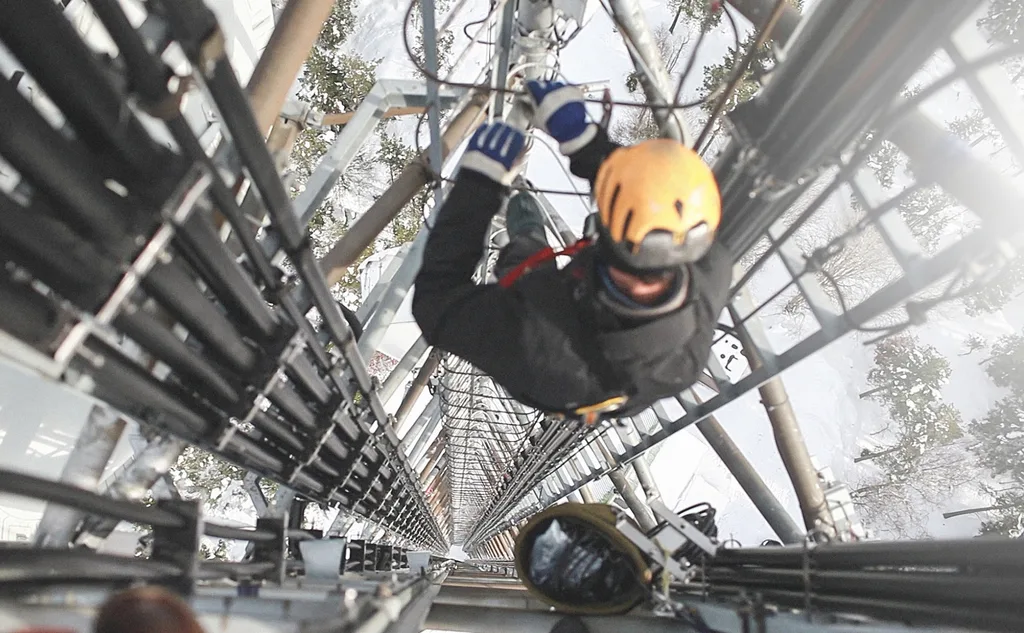Double danger
While the fall risks associated with working at height are well-documented, the less immediately apparent yet equally significant threat of chemical exposure often exists alongside them. Choosing Personal Protective Equipment (PPE) that effectively addresses both hazards involves a nuanced balance of material compatibility, ergonomic considerations, and performance demands, says Steve Marnach.

WORKING AT height remains one of the most high-hazard activities across industrial and construction sectors. As consistently shown by the Health and Safety Executive (HSE) in the UK and the Occupational Safety and Health Administration (OSHA) in the US, Falls from Height (FFH) are a leading cause of workplace fatalities, particularly in the construction industry. The HSE data for 2023/241 specifically identifies FFH as the biggest single cause of death in UK construction2, with more than one-third of the 138 workplace fatalities recorded in 2023/24 attributable to FFH. OSHA also highlights falls as the leading cause of death in US construction.
FFH commonly occur when workers fall from ladders, scaffolding, or work platforms, through fragile surfaces or unprotected openings, or from vehicles during loading and unloading. Multiple factors contribute to FFH accidents, stemming from human error such as over-confidence, misjudgment of distance, and failure to use safety equipment; environmental conditions like wet or slick surfaces, trip hazards, and inadequate warning notices; and challenging light levels, including low ambient light, dense shadows, or glare from spotlights.
While FFH often results in injuries like sprains and fractures, leading to lost productivity and significant personal discomfort, the ultimate consequence can tragically be the loss of life.
The European Directive 89/656/EEC3 requires employers to establish robust fall protection measures for personnel working at height. This includes designing workplaces to inherently prevent falls from elevated areas and into openings, prioritising engineering controls like physical guardrails to minimise risk.
When these preventative measures are not feasible, alternative protective solutions must be implemented. When working at height is unavoidable, providing professionally trained workers with suitable Personal Protective Equipment (PPE) is crucial for mitigating residual risk. The EU Directive clearly states that such PPE must:
- be appropriate for the risks involved, without leading to an increased risk
- correspond to existing conditions at the workplace
- take into account ergonomic requirements and the worker’s state of health
- fit the wearer correctly after any necessary adjustment.
The challenges of combining chemical and fall protection
When working at height, the inherent risks are considerably increased by the frequent presence of potentially hazardous chemicals in industrial and construction environments.
Working in a vertical environment frequently presents a complex array of additional hazards, including exposure to harmful chemicals like cleaning products, paints, and solvents, as well as the less visible but equally dangerous threat of hazardous dusts such as asbestos and polychlorinated biphenyls (PCBs). For example, demolition workers frequently encounter asbestos, cement, or brick dust, while maintenance personnel may utilise harmful chemicals for tasks like paint stripping or window washing. Protecting worker safety therefore extends beyond fall prevention; and the simultaneous requirement to guard against chemical exposure considerably complicates safety protocols and PPE selection.
This dual threat is underscored by findings from OSHA and Frost & Sullivan’s 2022 market report4, which indicate that fall protection is the single most frequently cited safety violation, and 36% of injuries resulting from a fall from height are attributable to impairment or other factors related to exposure to chemicals or hazardous substances.
The fact that a significant percentage of falls from height are linked to chemical exposure emphasises the vital importance of proper chemical handling and safety procedures for elevated work. Chemical exposure can induce dizziness, eye irritation, nausea, or headaches, directly increasing the likelihood of an FFH incident, while chemical contamination can degrade or weaken fall arrest harnesses.
Implications for PPE design
Effectively tackling these dual threats presents significant and unique challenges for health and safety managers. They need to carefully specify PPE that can work in harmony to give workers the necessary and complete protection – a difficult task given that safety harnesses and protective coveralls are designed with different core priorities.
Safety harnesses are engineered to fit snugly and supportively, typically constructed from robust materials such as DuPont Kevlar fibre, nylon, or polyester, all chosen for their strength and water resistance. The inclusion of multiple connection points via D-Rings, strategically positioned on the back, front, and sides of the harness, not only allows for connection with minimal hindrance but also provides redundancy in the event of a single point of failure.
In contrast, protective coveralls are designed to establish a physical barrier between the wearer and chemical hazards, whether in aerosol, liquid, or solid form. Effective protection requires full body coverage with secure seals at the wrists, ankles, and neck or head, along with protective zipper flaps to minimise leakage. These garments should ideally combine the adequate protection level, durability to ensure protection over time, being lightweight and featuring generous sizing, particularly in high-movement areas like the crotch and under the arms, to enhance wearer freedom and comfort.
The inherent and often conflicting design of these two essential PPE items can lead to compatibility issues, making it a challenge to combine them without potentially affecting their individual performance and safety.
Combining harnesses and coveralls
When risk assessments necessitate the simultaneous use of a safety harness and a protective coverall, determining the optimal donning sequence is key. Initially, positioning the harness over the coverall might seem logical; however, this approach can result in material bunching, leading to wearer discomfort and potentially compromising the harness's intended fit and functionality. Furthermore, the D-rings and associated hardware can snag the coverall fabric, causing abrasion and tears that diminish its chemical barrier properties. Wearing the harness over the coverall also exposes it to potential chemical contamination and degradation, reducing its performance and service life.
Conversely, donning the harness first, followed by the coverall, would mitigate the risk of harness contamination. However, this sequence impedes access to the harness's D-rings, hindering the safe attachment of carabiners and ropes so the coverall effectively obstructs access. In response to this, some workers resort to creating access holes in their coverall, a practice that severely compromises its chemical protective capabilities and invalidates CE certification.
From a safety standpoint, neither of these scenarios is acceptable. While each PPE item may be individually compliant and effective, their combination can result in inadequate overall protection, introduce new hazards, and negatively impact the fit and function of the other.
Deliver design innovation
Addressing the challenge of chemical hazards degrading safety harnesses and posing risks to wearers, DuPont collaborated with specialist manufacturers to develop a protective garment designed for use over full-body harnesses. The development process prioritized compatibility with various harness brands and models, incorporating rigorous testing to ensure seamless integration and uncompromised functionality. This included dynamic fall testing with an articulated dummy to verify that the coverall did not impede the harness's critical safety performance when worn underneath. The final garment design underwent independent validation by an external testing laboratory.
The resulting product, DuPont Tyvek 500 HP model TY178 coverall, offers an effective solution as a single-use, multi-attachment garment. Engineered to be worn over safety harnesses, the design provides a barrier, protecting both the wearer and the harness from exposure to chemical particles, light liquids, and aerosols, thereby extending the harness's service life.
The garment allows full freedom of movement and incorporates strategically placed access points for efficient deployment of all harness attachment elements. Key design objectives included:
- Precise alignment and easy access to all D-Rings without garment removal or adjustment
- Comprehensive protection for the wearer from chemical hazards
- Effective protection for the harness to maximise its longevity.
Looking ahead
The journey towards fully mitigating the dual risks of falls and chemical exposure at height is ongoing. Future advancements in PPE will likely focus on even greater integration of protective features, enhanced material science for improved comfort and durability, and smarter technologies for real-time monitoring and hazard detection. Continued collaboration between PPE manufacturers, chemical specialists, and end-users will be crucial in driving this innovation forward, ultimately striving for work environments where these complex hazards are effectively and comprehensively addressed.
DuPont has published a Working at Heights e-Guide for HSQE managers. It provides guidance on how to select and use PPE for working at heights, focusing on the challenge of combining fall and chemical protection. The e-Guide can be downloaded here: www.dupont.co.uk/personal-protection/working-at-heights-protection.html
Steve Marnach is EMEA training manager at DuPont Personal Protection. For more information, visit www.dupont.com
References
1 www.hse.gov.uk/statistics/fatals.htm
2 www.osha.gov/stop-falls
3 https://osha.europa.eu/en/legislation/directives/
4 Frost & Sullivan market report 2022: North American Fall Protection Growth Opportunities Stringent Regulations and End User Safety Awareness to Foster Product Penetration.
HSM publishes a weekly eNewsletter, delivering a carefully chosen selection of the latest stories straight to your inbox.
Subscribe here





